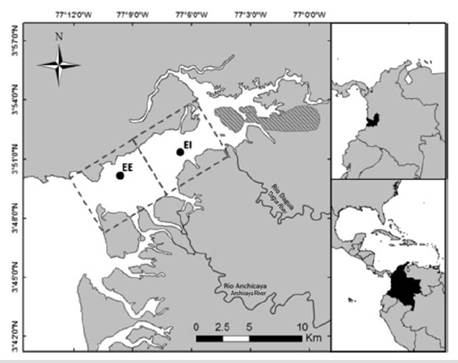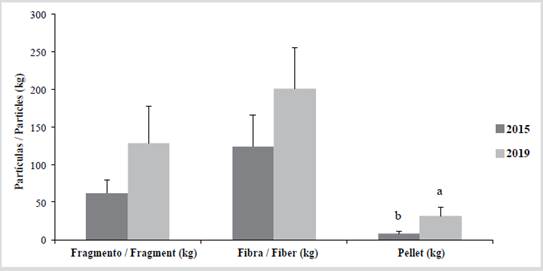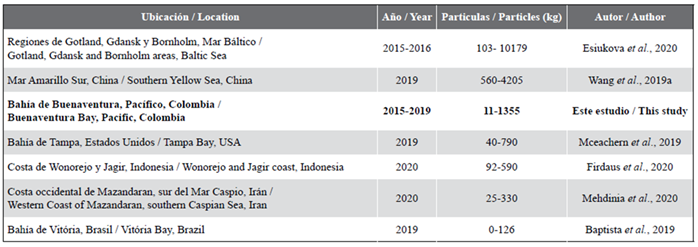INTRODUCTION
Microplastics are little, smaller than 5 mm in size plastic pieces that could be intentionally produced (primary microplastics) for use in consumption or abrasive products, or resulting from the fragmentation of bigger plastic products (secondary microplastics), considered as highly persistent and harmful pollutants for organisms (Van Cauwenberghe et al., 2015; Auta et al., 2017; Prata et al., 2019). Some plastics are not eliminated by waste management systems and they get into the rivers and the sea, which along with plastics directly discharged to water bodies, produce an estimate between 5 and 13 million tons of dumping to the sea every year (Matsuguma et al., 2017). Plastic wastes are heterogeneously distributed in marine ecosystems worldwide, such as oceanic islands, poles, and marine depths, driven by oceanic currents, wind, river outflows, and drifts (Cole et al., 2011). While primary microplastics are manufactured to have microscopic size, secondary microplastics are formed by fragmentation of bigger plastic objects (Lehtiniemi et al., 2018) due to continuous weathering (UV radiation and physical erosion) in the sea environment (Saley et al., 2019). The small size of microplastics makes them easily ingested by a wide range of marine species from planktonic invertebrates, fish, up to big mammals (Karbalaei et al., 2019; Tafurt, 2020).
Microplastics show different buoyancy degrees, most of them (polyethylene and polypropylene) are less dense than seawater and tend to float on the sea surface, while the densest could sink and get to the seabeds. Floating microplastics are colonized by microorganisms forming biofilms that increase density and decrease buoyancy, being an important mechanism for them to settle from the water column to the seabed (Van Cauwenberghe et al., 2015; Wessel et al., 2016; Auta et al., 2017; Matsuguma et al., 2017). Likewise, light microplastics could form agglomerates facilitating their vertical transfer to the sea depths and seabeds (Peng et al., 2020). It has been recorded that, over time, microplastic particles accumulated in sediments could be resuspended due to bioturbation, storms, upwelling events, or activities such as dredging, and undergo changes in their physical characteristics (size, shape, density) (Carbery et al., 2018; Molina et al., 2020).
Microplastics represent a significant environmental problem because their small size and density make them accessible for ingestion by many organisms at different trophic levels (Reed et al., 2018; Tafurt, 2020). Pelagic and demersal filterers, suspension feeders and benthic deposit feeders, macroinvertebrates, fish, reptiles, and mammals are found among the ingestion-vulnerable organisms, which ingest them either directly or through ingesting other organisms (Guzzetti et al., 2018; Reed et al., 2018).
Some of the adverse effects of this material on organisms include internal and external injuries, feeding alteration, growth retardation, and fertility reduction (de Sá et al., 2018). Likewise, microplastics can be a vector for toxic compounds (persistent organic pollutants and heavy metals) in marine organisms because of the chemical additives added to the plastic during its manufacture, and they tend to absorb and accumulate pollutants from the surrounding water, a process favored by their shape and size, which give them great surface/volume ratio. Microplastics show also a high probability of leaching plastics additives that can indice toxic effects in the aquatic biota (Wang et al., 2019b; Zhang et al., 2020a; Gamboa-García et al., 2020). Due to this, microplastics do not only cause mechanical damage to organisms, but they also can introduce polluting compunds through the trophic network (Guo and Wang, 2019).
Sediments could act as source and sinkhole for microplastics and play an important role in the distribution regulation of that pollutant in marine environments, where the concentration of present microplastics provides an indicative parameter of the pollution level (Yao et al., 2019). On the sea bed, polluted microplastics get in touch with nonpolluted sediments, creating a concentration gradient that allows the desorption of pollutants to the sediment’s organic matter (Cole et al., 2011).
Between 4.8 and 12.7 million metric tons of plastic waste arrived in the ocean in 2010, and it is estimated that 5 trillion plastic pieces are currently floating on the sea (Wessel et al., 2016). Buenaventura Bay is a vulnerable estuary to this type of pollutant, and their communities of benthos, macroinvertebrates, and fish (Gamboa et al., 2018; Martinez et al., 2019; Duque et al., 2020; Molina et al., 2020) could be affected by ingestion of microplastics (Tafurt, 2020). The objective of this research was to determine the distribution, density, and type of microplastics in sediments in the Buenaventura Bay estuary, Colombian Pacific, comparing two sites of the estuary in three climatic seasons in years 2015 and 2019.
STUDY AREA
The study area is the Buenaventura Bay estuary, located between latitudes 03º44’N and 03º56’N, and longitudes 77º01’W and 77º20’W (Figure 1). Its width ranges from 5.5 km in the internal part and 3.4 km in the external part (estuary entrance), with narrow and elongated shape (Otero, 2005). The climate of the Colombian Pacific is highly influenced by migrations of the Intertropical Convergence Zone and the proximity to the Andean mountain range, making it one of the most humid areas in the world (approximate rainfall of 6,980 mm year-1). It has two rainfall peaks, a minor one during April-May and the main one during September-November (Lobo-Guerrero, 1993), and two lesser rainfall or “dry” seasons during December-March -the main one- and June-August -the transition one. On the other hand, temperatures are greater than 24 ºC (Palacios et al., 2019) and relative humidity between 80 % and 95 % (Lobo-Guerrero, 1993). The Buenaventura Bay ecosystem has a high level of anthropic intervention, harbors a population of 300,000 inhabitants (DANE, 2019), and it is the most important Colombia’s seaport (Vega et al., 2019).
MATERIALS AND METHODS
Sampling design
36 samples of sediment were collected in 6 samplings, carried out during April, July, and November 2015, and March, June, and October 2019 corresponding to the predominant climatic seasons in the area [dry season (March-April), transition season (June-July), and rainy season (October-November)]. In each sampling, three samples of sediment were collected in each of the sampling areas, close to specific spots that allow the comparison between samples (EI, EE; Figure 1), at an average depth of de 2.1 ± 0.6 m. The internal estuary area (EI), with samples collected close to 77°6’33.1’’ W and 03°50’51.5’’ N, corresponds to the estuary area most influenced by the rivers, while the external estuary area (EE), with samples collected close to 77°9’35.9’’W and 03°50’58.7’’N, is characterized by having greater marine influence (Gamboa et al., 2018) (Figure 1). Samples were collected using a 50.8 mm internal diameter corer, taking the first 5 cm of sediment and then storing and refrigerating them.
Separation and identification of microplastics
Different methodologies were adapted to carry out the separation of microplastics from the sediment (Masura et al., 2015; INVEMAR, 2017a). Samples were inspected to ensure materials size (sediment and microplastics) lower than 5 mm. Sediment samples were dried at 90 ºC in a Memmet 30-750 oven for 24 hours and then they were weighted in an Adam SPB 723e analytical scale, recording the total dry weight. Likewise, for the separation of microplastics by density, a saline solution made up of 300 ml of distilled water and 90 g of marine salt was used to achieve an approximate density of 1.6 g/ml. To facilitate proper dissolution, it was stirred at 600 rpm and 60 ºC for 10 minutes in a Heidolph PT1000 medium shaking plate; then it was later filtered using a 125 µm metallic sieve to eliminate higher size salt particles. Then, the saline solution was added to the beaker containing the sample and it was stirred at 600 rpm for 10 minutes, to deposit it in a 1L capacity Imhoff cone; after 30 minutes of separation by density, the supernatant material (containing microplastics and vegetal material) was stored and dried at 90 ºC for 24 hours to determine the total solids mass.
Due to the high content of vegetal material in the supernatant samples, they were oxidized using 14.54 % sodium hypochlorite; 20 ml of hypochlorite were added to each sample with the collected solids and it was left oxidizing from 24 to 48 hours, as necessary. At the end of the oxidation time, the resultant material (microplastics) was cleaned using distilled water and a 125 µm metallic micro sieve; the clean material was transferred to dry it at 80 ºC for 24 hours, so determining the microplastics weight. The identification of microplastics was carried out using the ZEISS AxioCam microscope, where particles were viewed and photographed with the digital camera and the microscope software. The microplastic particles were classified according to their shape, and their respective sizes were measured with the microscope software rule. The shapes were classified as fibers, fragments, and pellets, while sizes were grouped within a range from 150 and 3,200 µm.
To reduce the risk of cross-contamination in the laboratory, each element used was previously washed and sealed while containing the sample. To minimize microplastics overestimation, especially fibers, elasticity tests were carried out using clamps (for fibers which size would allow it). And in the second place, the particles were viewed through the stereoscope and the microscope, eliminating those showing similar structures to vegetal ones.
Statistical Analysis
Permutational Multivariate Analyses of Variance (PERMANOVA) were carried out to determine the significant differences, where significance values [p(PERM)] were found using 9,999 permutations, accepting value α<0.05 as a statistically significant difference. Likewise, Pair-Wise Test (pos hoc tests) were carried out to identify significantly different groups (Walters y Coen, 2006; Clarke et al., 2014; Anderson, 2017; Ribeiro et al., 2019). Finally, percentage similarity analyses (SIMPER) with two-way Euclidean distance index were used to evaluate similitudes between types of microplastics, study areas and seasons in years 2015 and 2019 (Clarke, 1993; Clarke et al., 2014; Krishnapriya et al., 2019; Sañé et al., 2019).
RESULTS
The types of microplastics found for the study years (2015 and 2019) were fibers, fragments, and pellets (Figure 2). An average of 277.3 ± 52.1 particles/kg (average ± standard error) was found, where fibers predominated with 162.9 ± 34.3 particles/kg, followed by fragments and pellets, with 95.3 ± 26.3 and 20.1 ± 6.5 particles/kg respectively. Regarding recorded sizes, fibers showed an average length of 1253.1 ± 132.7 µm, fragments measured an average of 929.1 ± 123.7 µm, and pellets 671.7 ± 123.2 µm; likewise, it was noticed that the size of all found particles fell in a range of 150 to 3,200 µm (Table 1). About the evaluated periods, the transition one showed the largest quantity of microplastics (425.7 ± 130.6 particles/kg), while the lowest quantity was found in the dry season (132.0 ± 30.3 particles/kg). On the other hand, the greatest amount of microplastics was found in the internal estuary (302.2 ± 84.5) (Table 2).
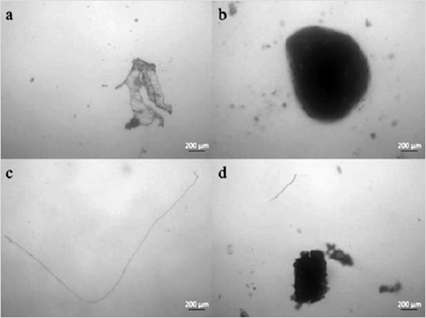
Figure 2 Types of microplastics found in the sediment samples. a) fragment; b) pellet; c) fiber; d) fragment and fiber.
Table 1 Sizes (Average ± SE) and ranges of the types of microplastics for years 2015, 2019, and both years.

Table 2 Microplastics density by seasons and estuary areas for the year 2015, 2019 and both years according to their classification (Average ± SE). Permanova pair-wise test results are shown with letters [p(PERM)<0.05], for the types of microplastics showing significant differences.
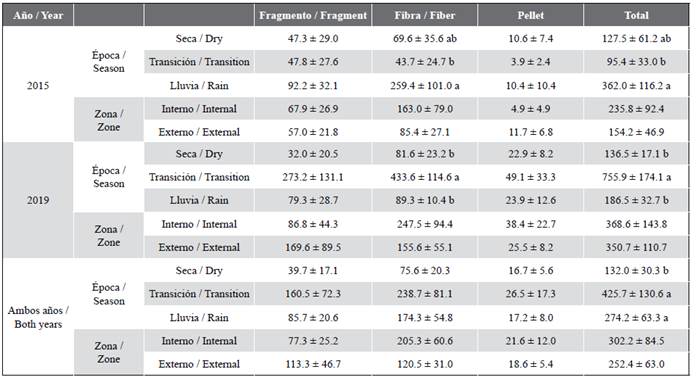
By 2015, microplastics found in sediment showed significant differences in the study seasons [p(PERM) = 0.037], which largest amount occurred in the rainy season with 362.0 ± 116.2 particles/kg and the lowest one in the transition season, with 95.4 ± 33.0 particles/kg (Table 2). The internal estuary showed variations in the accumulation of microplastics between the evaluated seasons, with no significant differences [p(PERM)>0.05], where the lowest density occurred in the dry season with an average of 53.6 ± 13.9 particles/kg and the highest one in the rainy season with an average of 488.6 ± 225.4 particles/kg. On the other hand, the external estuary presented higher accumulation of microplastics in the rainy season, followed by the dry and transition seasons, with averages of 235.3 ± 25.7, 201.5 ± 114.3 and 25.7 ± 8.9 particles /kg, respectively.
For the estuary in general, an average of 194.9 ± 51.3 particles/kg was recorded, where the presence of fibers predominated (124.2 ± 41.6 particles/kg), followed by fragments (62.4 ± 16.8 particles/kg), and pellets (8.3 ± 4.1 particles/kg). Regarding the total amount of microplastics, a total of 3509.5 particles/kg was estimated in the internal and external estuary of the Buenaventura Bay for the year 2015, with averages of 235.8 ± 92.4 and 154.2 ± 46.9 particles/kg for the internal and external estuary respectively.
The largest contributions in the differences of the microplastics distribution were made by fibers in the dry season (54.19 %) and in the rainy season (86.29 %), and by fragments in the transition season (55.66 %) (SIMPER). Fibers were the element with the greatest concentration in the dry season and the rainy season in the two areas of the estuary, followed by fragments in the internal and external estuary in the rainy season (Figure 3a y 3b); pellets showed low occurrence for the three seasons in the external estuary, being present only for the dry season in the internal estuary. Regarding microplastics size, fibers’ average lengths were 1189.81±178.0 µm and fragments showed an average size of 744.07 ± 116.7 µm (Table 1).
On the other hand, by 2019 there were significant differences between seasons [p(PERM)=0.007], where the largest amount of microplastics occurred in the transition season (755.9 ± 174.1 particles/kg) and the lowest in the dry and rainy seasons, with averages 136.5 ± 17.1 and 186.5 ± 32.7 particles/kg, respectively (Table 2). The internal estuary showed larger presence of microplastics in the transition season (763.4 ± 354.7 particles/kg), followed by the rainy season (191.0 ± 63.9 particles/kg) and the dry season (151.3 ± 27.4 particles/kg). Likewise, the external estuary showed an average accumulation of 748.4 ± 160.3 particles/kg in the transition season, 181.9 ± 35.4 particles/kg in the rainy season and finally, 121.7 ± 22.0 particles/kg in the dry season.
An average of 359.6 ± 88.0 particles/kg, was found for this year, 201.5 ± 54.2 particles/kg of which corresponded to fibers, 128.2 ± 49.5 particles/kg to fragments and 31.9 ± 11.8 to pellets. The estimated total amount of microplastics for both areas of the estuary was 6473.3 particles/kg. This year, the highest densities occurred in the transition season for both areas and all types of microplastics, except pellets in the external estuary. The second highest particle density occurred in the rainy season in both areas of the estuary, except pellets in the internal estuary, where they were absent. Fibers corresponded to the microplastic with the highest occurrence for both areas of the estuary and all the evaluated seasons, except for the transition season in the external estuary; however, fragments showed higher accumulation in the transition season in the external estuary (Figure 3c and d).
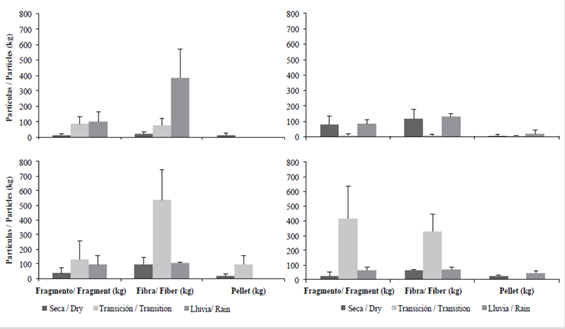
Figure 3 Microplastics density according to their classification (Average ± SE). a) internal estuary (EI) in the year 2015; b) external estuary (EE) in the year 2015; c) internal estuary (EI) in the year 2019; d) external estuary (EE) in the year 2019.
There were significant differences in the microplastics density among seasons [p(PERM) = 0.007]; sampling sites and the interaction between seasons and sampling sites showed no differences [p(PERM)=0.895 and p(PERM)=0.997, respectively].
Regarding the size of microplastics by 2019, fibers showed greater average size, followed by fragments and pellets (Table 1). The largest contributions in the microplastics’ distribution difference was made by fiber in the dry season (52.46 %) and by fragments in the transition season (54.69 %) and rainy season (75.54 %) (SIMPER).
When evaluating the differences between years, a significant increase was noticed in the average and total density of microplastics from 2015 to 2019 [p(PERM)= 0.038]. Fragments, fibers and pellets showed larger accumulated amount of particles in the sediment for 2019 (Figure 4), being pellets the material that increased most with respect to the amount found in 2015, followed by fragments and fibers with increases of 284.8 %, 105.3 % and 62.2 %, respectively. For both evaluated years, fibers were the most abundant.
DISCUSSION
Microplastics pollution in sediments in the Buenaventura Bay showed an increase of 84.4 % in the particles/kg average in year 2019, compared to 2015; it could be attributed to an inadequate disposal of plastic elements (macro and/or microplastics) in areas surrounding the bay like rivers, beaches, and the sea, where the sediment is the sinkhole of such pollutants (Zhang et al., 2020a), and to the slow degradation of these wastes, which entails a gradual increase of plastic waste in different marine environments (Cole et al., 2011; Gideon and Faggio,2019). In general, microplastics quantified in the Buenaventura Bay are found within the density ranges recorded by different researchers around the world (Table 3); in Colombia, instead, no published data were found about microplastics in subtidal sediments.
The average of microplastic particles found in the estuary for 2019 (359.6 ± 88.0 particles/kg) was similar to the findings in estuary Jagir, Indonesia, where 345.2 particles/kg of sediment were estimated (Firdaus et al., 2020), and greater than finding sin deep water sediments of the western Pacific Ocean, with a microplastics average concentration of 240 particles/kg (Zhang et al., 2020b). On the other hand, the microplastics average concentration determined for the mangrove soil of the Ciénaga Grande de Santa Martha, Colombian Caribbean, was 2,745 ± 1,978 particles/kg (Garcés et al., 2019), an amount greater than the one found in this research. This research’s results and the other results obtained, confirm that in subtidal areas of bays and estuaries and intertidal areas such as beaches, located near to urban environments, microplastics concentrate in greater amounts (Baptista et al., 2019). The upper basin of the Dagua River concentrates a high proportion of the populated municipal centers, so it contributes with the largest amount of domestic waters and solid waste from residential and productive activities into the main channel of the river; in addition, the population concentration in the lower basin has generated an increase of solid waste directly disposed into rivers and streams (Universidad del Valle, 2016; Aguirre et al, 2017).
Table 3. Comparison of microplastics density in sediments found in different research.
In general, fibers were the predominant type of microplastic in this study, with 63.7 and 56.03 % of the total of microplastics, for the years 2015 and 2019 respectively. This conforms to the findings in sediments in the Jagir estuary, Indonesia, where fibers comprised 57 % of the recorded microplastics (Firdaus et al., 2020). Likewise, fibers were abundant in the sediments of Bering and Chukchi Sea, with 64.4 % of the total abundance (Mu et al., 2019), and with 45 % of fibers predominance in sediments in the Western Pacific Ocean (Zhang et al., 2020b). High fiber contents in sediments could be related to fragments of fishing nets nylon, cleaning towels and hygiene products (Reed et al., 2018), and they are correlated to rainwater runoff, as well as to the high discharge of untreated or partially treated wastewater (Alves et al., 2019). In addition, fibers are the greatest contributor to the effluents from household washing machines, because a single clothing item can produce more than 1,900 fibers per wash (Dodson et al., 2020). The relation between the presence of microplastics and wastewater can explain their higher accumulation in the internal part of the Bay, which is closer to the urban center, the harbor and the wastewater discharge. It is necessary to take into account that fibers are the type of microplastic more susceptible of overestimation, although the methodology adopted in this research helped to reduce that risk.
The largest accumulation of microplastics in the internal estuary found in this study is similar to the findings in the Bering Sea, Chikchi Sea and the Bering Strait (Russia), where the abundance of microplastics gradually decreased when moving away from the mouth of the rivers and getting into the sea (Mu et al., 2019). The high density of microplastics reported in the transition season for 2019, could be attributed to dredging activities carried out in the area by these dates, which leads to drastic changes in the bottom topography, increases depth, and favors the settling of particles such as fine sediments, particulate material and pollutants (Rehitha et al., 2017). On the other hand, the removal of sediments and the characteristic swell of the Pacific Ocean, tides and water flows along the estuary, cause resuspension of microplastic particles (Peng et al., 2017), which, together with the density and floatability changes of microplastics due to interaction with microorganisms (Zhang et al., 2020b), may cause their redistribution, so increasing their abundance in superficial sediments in the evaluated years.
The rainy season showed a larger amount of microplastic particles deposited in the sediment compared to the dry season, maybe due to the larger drag of macro and/or microplastics by the increased runoff that introduces plastics deposited in beaches, creeks, and rivers into the estuary, where they are later distributed in surrounding areas under the action of swell, currents and wind speed (Baptista et al., 2019).
Finally, the relatively high density of microplastics and the considerable increase over time in the Buanventura Bay, pose an urgent need to address this issue. In the first place, regarding the mass consumption of macro and microplastics that produces an increase in their demand and their subsequent production, which generates larger amounts of waste that may end up in water sources and pollute rivers, streams, and the sea. In the second place, regarding the accumulation of this pollutant and its transformation in the marine ecosystems, which may generate ingestion, bioaccumulation and toxic effects in organisms; and in the third place, in terms of reducing the use of plastics, and improving the solid waste management systems and wastewater treatment plants that ensure a reduction in those and other pollutants.
CONCLUSIONS
The abundance of microplastics for the year 2015 was 194.9 ± 51.3 particles/kg and 359.6 ± 88.0 particles /kg for the year 2019, evidencing and increase of 84.4 % of microplastics in four years. In addition, microplastics were more abundant in the rainy season than in the dry season, with a considerable increase in the transition season of the year 2019, maybe due to a dredging operation in the bay. Regarding the spatial distribution, the internal estuary showed the largest amounts of microplastics, maybe proceeding from the proximity to the water source mouths, to the populated center and the harbor activities in the area. Fibers were the dominant microplastics, condition that can be attributed to fishing activities, inadequate disposal of textile elements and sewage discharge without previous treatment. Pollution generated by microplastics can produce risks and adverse effects for the marine communities compromising the food safety. In this way, it is necessary to identify the pollution sources of macro and microplastics, to generate control on them and reduce entering of these elements into aquatic ecosystems.











 text in
text in 


